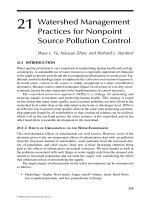HAZARDOUS AIR POLLUTANT HANDBOOK: Measurements, Properties, and Fate in Ambient Air - Part 5 (end) docx
Bạn đang xem bản rút gọn của tài liệu. Xem và tải ngay bản đầy đủ của tài liệu tại đây (1.91 MB, 52 trang )
© 2002 by CRC Press LLC
Atmospheric Transformation
Products of Clean Air Act Title
III Hazardous Air Pollutants
5.1 INTRODUCTION
Earlier chapters described the physical and chemical properties of the HAPs, methods that can be
used for their measurement, and representative atmospheric concentrations of these species. This
chapter deals with the atmospheric reactions that can transform these chemicals into other species,
and the processes that remove toxic chemicals from the atmosphere. Figure 5.1 shows schematically
some of the many processes that can affect the atmospheric concentration of a toxic air pollutant.
These processes can include chemical reactions such as reaction with hydroxyl radical (OH), ozone
(O
3
), nitrate radical (NO
3
), water vapor (H
2
O), or other atmospheric constituents. Reactions such
as these transform the toxic chemical into a different species. The original toxic molecule is no
longer present, but has been replaced by one or more new molecules. Compared with the original
HAP, the reaction products of HAP transformations can be more toxic, less toxic, or of similar
toxicity.
Physical processes can also transform or remove toxic pollutants from the air. As noted in
Figure 5.1, photolysis (the degradation of a molecule by absorption of light energy), can transform
those HAPs that can absorb light in the solar spectrum. The factors affecting photochemical
transformations are discussed in detail elsewhere.
1–4
Hazardous air pollutants also can be removed
from the atmosphere by deposition on surfaces, including soil, water, and vegetation. HAPs in the
particle phase can be removed by direct deposition on surfaces (dry deposition) or by scavenging
by cloud or rain droplets (wet deposition). Gas phase HAPs can deposit directly on surfaces, be
scavenged by precipitation or clouds, or be adsorbed on particles that are then removed by wet or
dry deposition.
FIGURE 5.1
Chemical and physical processes affecting HAPs in the atmosphere.
5
Particles
Gases
Source
of
Chemical
Surface (soil, vegetation, water)
Wet
or
Dry
Deposition
Products
Chemical Reactions
OH, O
3
, H
2
O, NO
3
, light, etc.
Stratosphere
Resuspension
Vaporization
Wet
or
Dry
Deposition
© 2002 by CRC Press LLC
These transformation and removal processes affect the fate of the HAP as well as its atmospheric
persistence. Human exposure to the HAPs is influenced by the length of time the HAP remains in
the atmosphere (persistence) and by its transformation to other chemical products or removal from
the air (fate). The Clean Air Act identifies the need for “consideration of atmospheric transformation
and other factors which can elevate public health risks from such pollutants.” Atmospheric trans-
formations of hazardous pollutants could result in products of higher or lower human health risk.
A first step in ascertaining the effect of atmospheric transformations of HAPs on human health
involves determining the nature of the transformation products. The reactions and products of some
HAPs have been widely investigated, but information on the transformations of many HAPs is
scarce or nonexistent. This chapter presents a review and summary of available literature on HAP
transformation products. Where possible, we also have summarized information on the atmospheric
lifetime of each HAP and the major processes affecting the lifetime. The focus of this chapter is
a summary of information on the products of HAP transformations and the persistence of HAPs
in the atmosphere. However, a short overview of the experimental methods used to study HAP
transformations is presented first to assist the reader in understanding the complexities and uncer-
tainties in the available information for the 188 HAPs.
5.2 EXPERIMENTAL APPROACHES FOR THE STUDY OF HAP
TRANSFORMATIONS
The photochemistry and reaction kinetics of atmospheric contaminants have been studied experimen-
tally for several decades, and the investigation of HAP transformations is simply a subset of this
broader field. Many of the experimental methods used to estimate reaction rate constants and to
determine reaction products for other atmospheric constituents have been applied to the study of the
HAPs. We can categorize experimental investigations of HAP transformations into three types:
1. Kinetics studies to determine rate constants
2. Product studies
3. Studies designed to measure both the kinetics and reaction products.
The persistence, or lifetime, of a chemical in the atmosphere can be estimated using the rate
constants for the most important atmospheric reactions of the chemical. The exponential lifetime,
or natural lifetime, is defined as the time required to reduce the concentration of a chemical to l/e
of its original value, where e is the base of natural logarithms (e
≈
2.718). The rate expression for
a typical first order reaction is:
where C
o
is the initial concentration of the chemical, C is the concentration at a later time, k is the
reaction rate constant, and t is the reaction time. For the special case where the initial concentration
of the chemical is reduced to l/e of its original value,
C
o
C
ln kt=
C
o
C
ln eln 1 kt===
© 2002 by CRC Press LLC
and the reaction time t is defined as the lifetime,
τ
. For this case, the lifetime is simply
τ
= l/k
Establishing the true atmospheric lifetime of a chemical would require summing the rate
constants for all the pertinent reactions, but frequently one reaction so dominates the removal of a
chemical that the chemical’s atmospheric lifetime can be approximated using the rate constant for
that reaction alone.
For higher order reactions, the concentration of one or more reaction partners is included in
the rate expression. For example, many organic chemicals react rapidly with hydroxyl radical in
the atmosphere, and the lifetime of the chemical can be approximated by
However, because [OH] varies widely with the time of day, location, and even season of the year,
the assumed concentration of the reaction partner should be noted with the lifetime estimate.
Experimental investigation of reaction kinetics or reaction products typically involves use of a
reaction vessel and an analytical system. Depending on the nature of the reaction being investigated
and the analytical requirements, the reaction vessel can be large (e.g. a room-size environmental
chamber) or small (e.g. a laboratory flask). Larger vessels may be required when the analytical
system needs large sample volumes, or when the surface-to-volume ratio must be minimized to
reduce the effect of surface reactions. Studies of reaction kinetics that measure the changing
concentration of only one or two reactants can often be conducted in small laboratory vessels,
whereas investigations that employ a number of measurement approaches to search for reaction
products usually need large volumes of sample and require larger reaction vessels. Because much
of the progress in the study of HAP transformations has involved use of large environmental
chambers, some examples are described below.
Two views of an environmental chamber used to study HAP reactions are shown in Figure 5.2.
Sampling and analysis systems on the two sides of the 17 m
3
chamber measure specific reactants
or products (e.g., NO, NO
2
, CO, formaldehyde, peroxyacetyl nitrate, etc.), while other gas chro-
matographic and mass spectrometric instruments can search for numerous unknown reaction prod-
ucts or can measure several reactants and products simultaneously. Other instruments measure
reaction conditions (temperature, humidity, light intensity, etc.). The large sample volumes required
by these instruments dictate the need for a large reaction vessel. Studies with lower sample volume
requirements can utilize smaller reaction vessels. Figure 5.3 is an example of a 200-L pyrex chamber
with an artificial light source.
The reaction vessels in Figures 5.2 and 5.3 represent fixed volume chambers with artificial
light sources to initiate photochemical reactions. Another type of chamber (Figure 5.4) employs
large plastic bags of Teflon or similar material. These “variable volume” vessels collapse as sample
air is withdrawn, eliminating the need for dilution air required by fixed volume vessels. Also,
because the plastic container transmits sunlight well, it can be used outdoors with natural sunlight
as the source of radiation for photochemical reactions.
The selection of a reaction vessel for kinetics and reaction product experiments involves many
choices and some compromises. Size, shape, surface material, irradiation source, indoor or outdoor
use, clean air source, analytical instruments, and cleaning procedures are just a few of the variables
that must be considered. Furthermore, a reaction vessel that is well suited to investigate reactions
of one class of chemicals may not be ideal for another class. An overview of reaction vessels and
experimental methods to study atmospheric reactions can be found in Finlayson-Pitts and Pitts.
4
τ
1
kOH[]
=
© 2002 by CRC Press LLC
FIGURE 5.2
Example of a large indoor environmental chamber used to study HAP transformation.
FIGURE 5.3
A small laboratory chamber used to study transformation of HAPs.
© 2002 by CRC Press LLC
5.3 HAZARDOUS AIR POLLUTANT TRANSFORMATIONS
For purposes of this survey, the 188 diverse chemicals designated as HAPs were organized into
chemical classes, as described in Chapter 2, to facilitate searching for transformation data. Infor-
mation on the transformation products of the 188 HAPs was located using a computerized database
and through a general review of articles, reference books, proceedings of relevant conferences, and
unpublished reports.
Relevant literature was identified through a keyword search of the computerized databases of
STN International (Columbus, OH). The databases searched included the Chemical Abstract (CA)
files from 1967 to the present, Chemical Abstract Previews (CAP) current files, and the National
Technical Information Service (NTIS) files from 1964 to the present.
The search strategy targeted keywords such as “atmospheric or air,” “reactions, kinetics or
removal,” and “rates, constants or lifetime.” The search was restricted to English-language citations.
The strategy used both abstract and basic index searches to increase the likelihood of finding
relevant material.
Using the search strategy described above, master sets of citations were set up in each of the STN
files researched. These master sets were then combined with the chemical names and CAS registry
numbers to produce citation listings for specific HAP compounds. The listed citations were then
reviewed by title and abstract and in their entirety if the initial reviews indicated information of value.
Another resource used to uncover transformation information was the computer database
ABIOTIK
x
.
5
This database was developed to provide the measured reaction rate constants for the
degradation of organic compounds in the atmosphere. Upon entering either the compound name
or its CAS number, a display is generated identifying published rate constants for several possible
atmospheric reactions for that chemical. This database also provides literature citations for the rate
data. In this study, the rate data were used to estimate lifetimes and identify significant transfor-
mation processes, and the cited literature was reviewed to identify reaction product information.
To assess the impact of atmospheric transformations of HAPs on the risk to human health, it
is important to know the products of the transformations, and also whether the rates of the
transformations are fast enough to remove the hazardous chemical or to cause the buildup of
hazardous levels of the products. Therefore, we searched for information on the lifetimes of the
HAPs, and the atmospheric processes that control the lifetimes. For many of the HAPs, the lifetime
is likely to be controlled by reaction with hydroxyl radical, while for others, reaction with ozone,
photolysis, or wet or dry deposition processes may control or at least influence the lifetime.
FIGURE 5.4
Outdoor Teflon chamber used to study HAP transformations.
© 2002 by CRC Press LLC
Information on the kinetics of atmospheric reactions has enabled us to list the primary removal
processes expected to control the lifetimes of many of the HAPs, and to estimate the lifetimes. The
lifetimes have been listed in our data summary within three broad ranges:
1. Less than 1 day
2. One to 5 days
3. More than 5 days
These estimates are meant to provide the reader with a sense of the residence times of these
species in the atmosphere. The three broad lifetime ranges represent species that are rapidly
transformed or removed (
τ
< 1 day), moderately persistent (
τ
= 1-5 days), or highly persistent (
τ
> 5 days). The lifetime,
τ
, is the exponential lifetime described above, representing the time it takes
for the concentration of the HAP to decrease to 1/e of its original value.
In some instances, estimates of the atmospheric lifetime of the target chemicals have been
reported in the literature. In other cases, we used reported rate constants to identify the most
important removal processes and to calculate a corresponding lifetime. For those cases, we assumed
the following reactant concentrations in the calculations, to represent long-term average concen-
trations in a relatively polluted atmosphere:
Measured rate constants were not available for all of the pertinent reactions. When we could
not find an experimentally measured rate constant, we used published rate estimates based on
molecular structure. These cases are identified with an asterisk in our data summaries.
In some instances, there was disagreement among rate constants or lifetimes for a selected
HAP from multiple references. In these cases, we have listed a range of lifetimes.
Available information on HAP transformation products is compiled in Table 5.1 (see Appendix
following Chapter 5). The table is followed by an associated list of 190 citations to relevant literature.
The data table lists all 188 HAPs in the same order as in the CAA, giving the name and CAS
number of each compound, the chemical formula or structure, the major removal processes, the
atmospheric lifetime range, the reported transformation products, references for the reported data,
and any additional comments or notes. An asterisk in the last column indicates that the atmospheric
lifetime was based on rate constants estimated from structure–reactivity relationships. The trans-
formation products are not listed in any particular order. Many of the references report qualitative
information only, so we have not attempted to rank the products by abundance.
A review of Table 5.1 shows that information was found on removal processes, lifetimes, and
transformation products for 94 of the 188 HAPs. Twelve compounds were identified as being
unlikely to undergo any significant chemical transformation. We were unable to find reported
transformation products for 82 compounds that are expected to undergo transformations. We found
no relevant information on either atmospheric persistence or products for five compounds. It should
be noted that, although transformation products have been reported for 94 of the HAPs, for many
of these compounds, the list of products is probably incomplete.
The transformation products listed in Table 5.1 cover a wide range of chemical compositions.
Many of the HAP compounds react with OH radical and are degraded to low molecular weight
aldehydes, alcohols, organic acids, ketones, nitrates, carbon monoxide, carbon dioxide, and water.
Many of the transformation products are multifunctional organic compounds. Some HAPs are trans-
Reactant
Concentration
(molecules/cm
3
)
O
3
1.5
×
10
12
OH 3.0
×
10
6
NO
3
2.5
×
10
9
HO
2
1.0
×
10
9
© 2002 by CRC Press LLC
formed to other HAP species, so the degree of health risk depends on the relative toxicity of the
original HAP and its transformation products. A further breakdown of HAP transformations is given
in Table 5.2, which shows that many of the 82 compounds that may react in the atmosphere, but for
which no transformation product data were found, are oxygenated and nitrogenated organic com-
pounds. Even for those chemicals with reported reaction products, the list of products may well be
incomplete, depending on the rigor of the experimental study. For example, few studies have reported
mass balances to document the completeness of the list of products. This lack of product data
represents a serious gap in our knowledge about hazardous air pollutants and affects our ability to
assess the health risks posed by their atmospheric transformations. Additional research is needed to
elucidate the products and lifetimes of HAPs representing various classes on the HAPs list.
The process that drives the transformation of many of the HAP compounds in the atmosphere
is reaction with hydroxyl radical (OH). Of the 181 HAPs for which a tropospheric removal process
is reported in Table 5.1, 86% show reaction with hydroxyl as an important removal mechanism.
This is consistent with the hydroxyl radical’s known role as an “atmospheric cleanser.” Thompson
6
has reviewed the hydroxyl radical and other species that control the atmosphere’s oxidizing capacity.
Reactions with ozone and nitrate radical contribute to the removal of a number of the HAPs, but
these reactions appear to control the lifetimes of only a few of the species. Photolysis is also an
important degradation mechanism for a number of the HAPs, and is thought to be the primary removal
mechanism for 17 chemicals (one of these, CCl
4
, is removed by photolysis in the stratosphere).
Deposition was identified as the primary removal process for a number of the HAPs, especially those
that exist in particle form and those that are not expected to undergo significant chemical transfor-
mation in the atmosphere. Consequently, their removal is expected to be controlled by physical removal
processes (wet and dry deposition). For seven of the HAPs, reaction with or in liquid water is listed
as the major removal pathway. The lifetimes of these species are expected to be controlled by this
reaction when liquid water is present (in the form of clouds, precipitation, over bodies of surface
water) but to be dominated by other removal mechanisms in the absence of liquid water. One of the
HAPs (radionuclides including radon) is removed by radioactive decay or deposition.
The persistence of a hazardous chemical in the atmosphere influences the route by which
humans may be exposed to it and also the extent of population exposure. A chemical with a very
short lifetime will often be transformed to products or removed from the air before large populations
TABLE 5.2
Data Completeness by Compound Class
Compound Class
Data Reported for
Removal Process,
Lifetime and
Transformation Products
No
Product
Data
No
Transformation
Anticipated
No
Data
Hydrocarbons 3 0 0 0
Halogenated Hydrocarbons 19 7 1 0
Aromatic Compounds 16 3 0 1
Halogenated Aromatics 5 3 0 0
Nitrogenated Organics 14 36 0 3
Oxygenated Organics 23 15 0 0
Pesticides/Herbicides 4 11 0 1
Inorganics 18 4 11 0
Phthalates 0 3 0 0
Sulfates 2 0 0 0
Total 94 82 12 5
© 2002 by CRC Press LLC
are exposed, whereas very persistent chemicals may be transported over large distances (sometimes
even globally) with the concomitant exposure of large numbers of people via inhalation. Of course,
the location and distribution of emission sources also plays a major role in population exposure,
but the atmospheric lifetime is an important factor.
We classified the atmospheric lifetimes of the HAPs into the three previously described
broad ranges in Table 5.1. Seventy-one of the HAPs (38%) are reported to have lifetimes of
less than 1 day. Another 27 compounds (14%) have intermediate lifetimes of 1 to 5 days, while
56 (30%) are fairly persistent, with lifetimes greater than 5 days. There are 21 HAPs for which
lifetime estimates are inconsistent. In these cases, the range of lifetime estimates is listed in
the table. For eight HAPs, the estimated atmospheric lifetime depends on the phase the chemical
is in. For many semivolatile species, the fraction existing in the gas phase is removed more
rapidly than that found in the particle phase.
No lifetime estimates were found for five chemicals. These species are: acrylamide,
chloramben, dimethylformamide, hexamethylphosphoramide, and coke oven emissions. The
latter HAP has no lifetime estimate due to the unspecified nature of the chemicals emitted.
The lifetime estimates suggest that hydrocarbons, nitrogenated organics, aromatic com-
pounds, sulfates, and pesticides and herbicides are generally expected to degrade fairly rapidly
in the atmosphere. The oxygenated organics are distributed evenly across the lifetime ranges.
The inorganics, halogenated hydrocarbons, and halogenated aromatics are reported to be
relatively persistent in the atmosphere. As a cautionary note, we find in Table 5.1 that com-
parisons of lifetimes among HAPs with structural similarities sometimes show inconsistencies.
The lifetimes reported in this document have been measured or estimated by a variety of
methods, which have not been reviewed for consistency. Consequently, the lifetime estimates
provided here should be used with caution.
5.4 TRANSFORMATIONS OF 33 HIGH PRIORITY HAPS
As described in Chapter 1, EPA has targeted 33 of the 188 HAPs as presenting the greatest threat
to public health in urban areas.
7
These 33 HAPs, along with diesel particulate matter, are being
included in a national assessment of toxic air pollutants to identify those that present the greatest
risk to public health.
An important question is how atmospheric reactions of the 33 high priority HAPs affect
the public health risk associated with these chemicals. Clearly, a knowledge of the lifetimes
of these species is important in assessing population exposure and the risk posed by these
chemicals. But it is also important to include the toxicity of their transformation products in
any risk assessment. Atmospheric reactions can transform some HAPs into innocuous products,
reducing the risks posed by these chemicals. But transformations can also produce pollutants
more toxic than the original HAP, and this transformation needs to be included in the risk
assessment process.
An overview of our knowledge about the atmospheric transformations of the 33 high priority
HAPs is provided in Table 5.3. The compounds on this list cover a broad range of chemical
categories, lifetimes, and transformation products. Twenty-four of these compounds are expected
to be fairly persistent, with lifetimes of a day or longer. Reaction with hydroxyl radical is expected
to be a major removal pathway for most of the 33 HAPs, but several other transformation and
removal routes are cited.
The last column in Table 5.3 indicates whether specific transformation products have been
identified for each compound. We found no information about atmospheric transformation products
for propylene dichloride, hexachlorobenzene, quinoline, or 1,1,2,2-tetrachloroethane. This repre-
sents an important gap in our knowledge about these high priority HAPs, and will add uncertainty
to the national assessment of the risks posed by these chemicals.
© 2002 by CRC Press LLC
5.5 TRANSFORMATIONS OF OTHER ATMOSPHERIC CHEMICALS
Besides transformations of the 188 HAPs, other atmospheric transformations can elevate the risk
to public health. Many chemicals that are emitted to the atmosphere, whether from anthropogenic
or natural sources, are not on the Title III list of 188 chemicals, and may not be toxic themselves,
TABLE 5.3
Overview of Lifetime and Transformation Data for 33 High Priority HAPs
Compound
CAS Registry
No. Major Removal Process
Atmospheric
Lifetime
(days)
Transformation
Products
Acetaldehyde 75-07-0 OH <1 Yes
Acrolein 107-02-8 OH <1 Yes
Acrylonitrile 107-13-1 OH 1-5 to .5 Yes
Arsenic compounds Deposition >5 No transformation
Benzene 71-43-2 OH >5 Yes
Beryllium compounds Deposition >5 No transformation
1,3-Butadiene 106-99-0 OH, O
3
<1 Yes
Cadmium compounds Deposition >5 No transformation
Carbon tetrachloride 56-23-5 Stratospheric photolysis >5 No transformation
(in troposphere)
Chloroform 67-66-3 OH >5 Yes
Chromium compounds Deposition >5 No transformation
Coke oven emissions * (a) (a)
1,3-Dichloropropene 542-75-6 OH, O
3
<1 Yes
Ethylene dibromide 106-93-4 OH >5 Yes
Ethylene dichloride 107-06-2 OH >5 Yes
Ethylene oxide 75-21-8 OH >5 Yes
Formaldehyde 50-00-0 Photolysis <1 Yes
Hexachlorobenzene 118-74-1 OH >5 No information
Hydrazine 302-01-2 OH <1 Yes
Lead compounds Deposition (inorganic compounds)
OH, O
3
(organo-lead compounds)
>5
<1 to 1-5
No transformation
Yes
Manganese compounds Deposition >5 No transformation
Mercury compounds Aqueous OH (elemental) Deposition
(particle phase)
>5 Yes
Methylene chloride 75-09-2 OH >5 Yes
Nickel compounds Deposition >5 No transformation
Polychlorinated biphenyls 1336-36-3 Photolysis, OH >5 Yes
Polycyclic organic matter
**
e.g. 85-01-8 OH <1 to 1-5 Yes
Propylene dichloride 78-87-5 OH >5 No information
Quinoline 91-22-5 OH 1 to 5 No information
2,3,7,8-Tetrachlorodibenzo-
p-dioxin
1746-01-06 Photolysis, deposition 1-5 to >5 (gas phase)
>5 (particle phase)
Yes
1,1,2,2-Tetrachloroethane 79-32-5 OH >5 No information
Tetrachloroethylene 127-18-4 OH >5 Yes
Trichloroethylene 79-01-6 OH, O
3
<1 to 1-5 Yes
Vinyl chloride 75-01-4 OH, O
3
<1 to 1-5 Yes
* Specific chemicals are not identified, so transformation information cannot be cited.
**Information cited for the representative compound phenanthrene.
© 2002 by CRC Press LLC
but can undergo atmospheric transformations that generate toxic products, some of which might
be HAPs. Although examination of non-HAP transformations is outside the scope of this chapter,
such transformations should be considered in assessing human exposure to toxic air pollutants. In
the paragraph below, one type of study addressing this issue is reviewed. This type of research is
investigating mutagenic activity from the atmospheric transformations of non-HAP compounds.
The significance of the findings with respect to public health risk merits our attention.
As noted above, there are non-HAP and even nontoxic compounds that undergo atmospheric
transformations to generate chemicals that may present human health hazards. An example of such
a compound is the simple hydrocarbon propene. It is reported that this ubiquitous ambient air
constituent, when irradiated in the presence of NO
x
, yields transformation products that are
mutagens. The products that have been identified from the atmospheric transformation of propene
include formaldehyde, acetaldehyde, peroxyacetyl nitrate, nitric acid, propylene glycol dinitrate,
2-hydroxy propyl nitrate, 2-nitropropyl alcohol,
α
-nitroacetone, and carbon monoxide.
8
These
products do not account for all of the mutagenic activity; other unidentified mutagens likely include
organic peroxides and nitrates. Further investigations of the transformation of propene by reaction
with O
3
9
and with hydroxyl and nitrate radicals
10
also identify organic oxygenates as products,
although they do not account for the mutagenic activity associated with propene/NO
x
transforma-
tions. This work demonstrates that compounds considered to be nontoxic can undergo atmospheric
transformations to produce HAPs, as well as other toxic pollutants. These studies were able to
demonstrate mutagenic activity, even though the specific mutagens could not always be identified.
This approach warrants careful consideration as a means of investigating the risks associated with
atmospheric transformations.
5.6 SUMMARY
This chapter has summarized available literature on the transformation products and atmospheric
persistence of the 188 hazardous air pollutants listed in the Clean Air Act. The atmospheric lifetimes
for all but five of the chemicals have been estimated, although there is inconsistency in the estimates
for 21 of the HAPs. The transformation product information is much less complete. Transformation
products have been identified for only half of the 188 chemicals.
The transformation products formed during the atmospheric reactions of HAPs include alde-
hydes, alcohols, peroxides, nitrosamines, nitramines, amides, organic acids, ketones, nitrates, carbon
monoxide, carbon dioxide, and a wide variety of other oxygenated, nitrogenated, halogenated, or
sulfur-containing species. Many of the products are multifunctional chemicals. Some of the products
are known to be toxic, while many others have never been tested for toxicity. Reaction products
have not been identified for 38 of the chemicals that are expected to react rapidly in the atmosphere
(lifetime < 1 day). Because these chemicals may be transformed to potentially toxic products
before atmospheric dilution has reduced their concentrations to negligible levels, knowledge of
the atmospheric reaction products is a priority.
Many of the 188 HAPs undergo transformations to produce other hazardous chemicals on the
HAPs list. For example, formaldehyde is a product of many HAP transformations. Transformation
products can be either more or less toxic than the original HAP. For example, one product of
chloroform oxidation (phosgene) is reported to be significantly more toxic than chloroform itself.
11
In addition, chemicals not currently identified as hazardous air pollutants can undergo atmospheric
transformations to generate toxic products (including HAPs) that pose a potential health risk to
humans.
Considerably more information must be gathered on the atmospheric reactions of many of the
HAPs before their transformations can be fully incorporated in health risk assessments. As a starting
point, efforts should be focused on the five HAPs for which neither lifetime nor product data are
available, and on those 38 HAPs that may undergo rapid atmospheric transformations, but for which
no transformation product data are available. The transformation products of this latter group of
© 2002 by CRC Press LLC
chemicals may build up relatively rapidly, and therefore could represent a health risk if they are
toxic. On the other hand, if the products are found to be nontoxic, then the rapid removal of these
HAPs from the atmosphere should also be taken into account in the risk assessment process. The
specific chemicals in these two groups are listed in Table 5.4. The elucidation of the transformation
products of these HAPs should be given a high priority.
REFERENCES
1. Leighton, P.A.,
Photochemistry of Air Pollution
, Academic Press, New York, 1961.
2. Calvert, J.G. and Pitts, J.N. Jr.,
Photochemistry
, Wiley, New York, 1966.
3. Heicklen, J.,
Atmospheric Chemistry
, Academic Press, New York, 1976.
4. Finlayson-Pitts, B.J. and Pitts, J.N. Jr.,
Chemistry of the Upper and Lower Atmosphere Theory,
Experiments, and Applications
, Academic Press, San Diego, 2000.
5. Daniel, B., Merz, G. and Klöpffer, W., ABIOTIK
x
Data-Base, Daniel Electronic, in behalf of Battelle
Institut e.V., Frankfurt, Germany, November 1990.
6. Thompson, A.M., The oxidizing capacity of the earth’s atmosphere: probable past and future changes,
Science
, 256, 1157, 1992.
7. U.S. EPA, National Air Toxics Program: The Integrated Urban Strategy, 64 FR 38705, July 19, 1999.
Available at: />8. Kleindienst, T.E. et al., The mutagenic activity of the products of propylene photooxidation,
Environ.
Sci. Technol.
, 19, 620, 1985.
TABLE 5.4
Recommended Priority HAPs for Transformation
Product Studies
Rapid Transformation/No Reaction Product Data
Acetamide 3,3
′
-Dimethoxybenzidine
2-Acetylaminofluorene Dimethylaminoazobenzene
Acrylic acid 3,3
′
-Dimethylbenzidine
4-Aminobiphenyl Dimethylcarbamoyl chloride
o-Anisidine 1,2-Diphenylhydrazine
Benzidine Ethyl carbamate
Bis(2-ethylhexyl) phthalate (DEHP) Ethyleneimine
Calcium cyanamide Heptachlor
Captan Isophorone
Carbaryl Lindane
Catechol Methoxychlor
Chlordane Methyl isocyanate
Chlorobenzilate 4,4
′
-Methylene bis (2-chloroaniline)
DDE 4,4
′
-Methylenedianiline
Diazomethane p-Phenylenediamine
Dibutyl phthalate Propoxur
3,3'-Dichlorobenzidine 1,2-Propyleneimine
Dichlorvos 2,4-Touenediamine
Diethanolamine o-Toluidine
No Lifetime or Reaction Product Data
Acrylamide Hexamethylphosphoramide
Chloramben Coke oven emissions
N,N-Dimethylformamide
© 2002 by CRC Press LLC
9. Shepson, P.B. et al., The production of organic nitrates from hydroxyl and nitrate radical reaction
with propylene,
Environ. Sci. Technol.
, 19, 849, 1985.
10. Shepson, P.B. et al., The mutagenic activity of the products of ozone reaction with propylene in the
present and absence of nitrogen dioxide,
Environ. Sci. Technol.
, 19, 1094, 1985.
11. Sittig, M.,
Handbook of Toxic and Hazardous Chemicals and Carcinogens
, 2nd ed., Noyes Publica-
tions, Park Ridge, NJ, 1985.
APPENDIX
TABLE 5.1
Summary of Hazardous Air Pollutant Transformations and Lifetimes (Chemicals shown in italics are high priority urban HAPs)
Compound and
CAS Number
Chemical
Formula/Structure
Major
Removal
Processes
Reported
Atmospheric
Lifetimes
(days)
Transformation
Products References Comments/Notes
Acetaldehyde
75-07-0
CH
3
CHO OH, photolysis <1 Formaldehyde, carbon
dioxide, carbon monoxide,
PAN, hydrogen peroxide,
methyl nitrate
1,2,4,5,13,14,16,
17,19,20,29,52,
54,55,69,79
Acetamide
60-35-5
CH
3
C(O)NH
2
OH <1 No information found 21 *
Acetonitrile
75-05-8
CH
3
CN OH >5 No information found 19,21,52,54,55,
69,101,102,106
Acetophenone
98-86-2
OH 1 to 5 No information found 55
2-Acetylaminofluorene
53-96-3
OH <1 No information found 21 *
© 2002 by CRC Press LLC
TABLE 5.1
Summary of Hazardous Air Pollutant Transformations and Lifetimes (Chemicals shown in italics are high priority urban HAPs)
Compound and
CAS Number
Chemical
Formula/Structure
Major
Removal
Processes
Reported
Atmospheric
Lifetimes
(days)
Transformation
Products References Comments/Notes
Acrolein
107-02-8
H
2
C=CHCHO OH, photolysis, O
3
<1 Formaldehyde, carbon
dioxide, glyoxal, formic acid,
peroxyacylnitrate
2,3,5,9,13,21,50,
52,54,55,79,93,
108,145,146,
166
Acrylamide
79-06-1
CH
2
CHC(O)NH
2
No information
found
No information
found
No information found Reaction with OH
and O
3
likely
Acrylic Acid
79-10-7
H
2
C=CHCO
2
H OH, deposition <1 No information found 17,21
Acrylonitrile
107-13-1
CH
2
CHCN OH 1-5 to >5 Formaldehyde, formic acid,
hydrogen cyanide, formyl
cyanide, oxalic acid
mononitrile
5,7,11,13,19,21,
52,102,103,
108,147
Allyl chloride
(3-chloro-1-propene)
107-05-1
CH
2
=CHCH
2
Cl OH, O
3
<1 Formaldehyde, formic acid,
chloroacetaldehyde,
acetaldehyde, 1,3-
dichloroacetone, acrolein,
glyoxal, PAN, Cl-PAN,
chlorinated hydroxy
carbonyls, formyl chloride
5,21,13,54,55,
93,137,146,
148,149,150
4-Aminobiphenyl
92-67-1
OH <1 No information found 21 *
© 2002 by CRC Press LLC
o-Anisidine
90-04-0
OH <1 No information found 21 *
Aniline
62-53-3
OH <1 Nitrosamines, nitramines,
nitrobenzene, formic acid,
hydrogen peroxide,
nitrophenols,
nitrosobenzene, benzidine,
amino-phenol, nitroaniline,
phenol, hydroxybenzonitrile,
N-phenyl-formamide
7,8,9,55,102
Asbestos
1332-21-4
Silicate minerals of the serpentine
and amphibole groups
Deposition >5 No chemical transformation 112
Benzene
71-43-2
OH, NO
3
>5 Phenol, nitrobenzene,
nitrophenol, dinitrophenol,
glyoxal, 2-butene-1,4-dial
7,8,9,14,17,19,
21,35,41,52,54,
55,65,151,189
Benzidine
92-87-5
OH <1 No information found 21 *
Benzotrichloride
98-07-7
OH >5 No information found 21 *
NH
2
H
2
NNH
2
© 2002 by CRC Press LLC
TABLE 5.1 (CONTINUED)
Summary of Hazardous Air Pollutant Transformations and Lifetimes (Chemicals shown in italics are high priority urban HAPs)
Compound and
CAS Number
Chemical
Formula/Structure
Major
Removal
Processes
Reported
Atmospheric
Lifetimes
(days)
Transformation
Products References Comments/Notes
Benzyl chloride
100-44-7
OH 1 to >5 Phenol, chloromethyl phenols,
ring cleavage products,
benzaldehyde, nitrobenzyl
chloride, chloromethyl
glyoxal, peroxybenzoyl
nitrate
5,21,31,52,54,
55,103,146,
148,152
Biphenyl
92-52-4
OH 1 to 5 3-Nitrobiphenyl, 2,3,4-
hydroxybiphenyl, 2-
hydroxybiphenyl
19,21,23,45,46,
47,48,49,50,52,
55,78,166
Bis(2-ethylhexyl)
phthalate (DEHP)
117-81-7
OH, deposition <1 No information found 21 *
Bis(chloromethyl) ether
542-88-1
ClCH
2
OCH
2
Cl Liquid H
2
O, OH <1 to 1-5 Hydrochloric acid, formalde-
hyde, chloromethylformate
5,21,130,131,
167
Rapid reaction with
liquid H
2
O
CH
2
Cl
C
OCH C
5
H
11
C
2
H
5
C
O
OCH
C
2
H
5
C
5
H
11
O
2
2
© 2002 by CRC Press LLC
Bromoform
75-25-2
CHBr
3
OH, photolysis >5 No information found 166 See chloroform for
analogous
pathways
1,3-Butadiene
106-99-0
H
2
C=CHCH=CH
2
OH, O
3
<1 Acrolein, formaldehyde,
glyoxal, trans-4-nitroxy-2-
butenal, 2-butanone, 1-
nitroxy-3-buten-2-one,
cyclohexanone,
glycolaldehyde, furan, 1,3-
butadiene monoxide,
glycidaldehyde, 1,3-
butadiene diepoxide, 3-
hydroxy-propanaldehyde,
propanal, hydroxyacetone,
malonaldehyde
15,17,21,50,52,
54,55,108,138,
145,153,162,
163,165
Calcium cyanamide
156-62-7
CaNCN OH, deposition <1 (gas phase)
>5 (particle phase)
No information found 21,166 *
Captan
133-06-2
OH <1 No information found 21 *
Carbaryl (Sevin)
63-25-2
OH, deposition <1 (gas phase)
>5 (particle phase)
No information found 21,166 *
Carbon disulfide
75-15-0
CS
2
OH 1-5 to >5 Carbonyl sulfide, sulfur
dioxide
17,19,26,119 Considerable
disagreement in
reported OH rate
constants
Carbon tetrachloride
56-23-5
CCl
4
Photolysis in
stratosphere
>5 No tropospheric reactions
anticipated
5,7,15,21,55,69
O
NH
O
H
3
C
© 2002 by CRC Press LLC
TABLE 5.1 (CONTINUED)
Summary of Hazardous Air Pollutant Transformations and Lifetimes (Chemicals shown in italics are high priority urban HAPs)
Compound and
CAS Number
Chemical
Formula/Structure
Major
Removal
Processes
Reported
Atmospheric
Lifetimes
(days)
Transformation
Products References Comments/Notes
Carbonyl sulfide
463-58-1
COS OH >5 Carbon dioxide, hydrogen
sulfide, sulfur dioxide
19,26,27,69
Catechol
120-80-9
OH <1 No information found 21 *
Chloramben
133-90-4
No information
found
No information
found
No information found
Chlordane
57-74-9
OH <1 to >5 No information found 21,136,166 Considerable
disagreement over
lifetime
Chlorine
7782-50-5
Cl
2
Photolysis <1 Hydrogen chloride 111
Chloroacetic acid
79-11-8
ClCH
2
CO
2
H OH, deposition >5 No information found 21 *
OH
OH
© 2002 by CRC Press LLC
2-Chloroacetophenone
532-27-4
OH >5 No information found 21 *
Chlorobenzene
108-90-7
OH >5 Chlorophenols, 1-chloro-3-
nitrobenzene, ring cleavage
products, chloronitrophenols
5,7,8,9,17,19,21,
23,42,50,55,
146,152
Chlorobenzilate
510-15-6
OH <1 to >5 No information found 21,166 *
Considerable
disagreement over
lifetime
Chloroform
67-66-3
CHCl
3
OH >5 Phosgene, hydrogen chloride 5,7,14,15,17,21,
22,54,55,69,
129
Chloromethyl
methyl ether
107-30-2
ClCH
2
OCH
3
Liquid H
2
O, OH <1 to 1-5 Chloromethyl formate, methyl
formate, methanol,
chloromethanol
5,21,130,167 Rapid reaction with
liquid H
2
O
Chloroprene (2-chloro
1,3-butadiene)
126-99-8
CH
2
=CHCCl=CH
2
OH, O
3
<1 Formaldehyde, ethanediol,
chlorohydroxy acids,
aldehydes, formic acid
5,21,146,149
Cresol/Cresylic Acid
1319-77-3
OH, NO
3
<1 Nitrocresols, ring cleavage
products
5,21
C
O
CH
2
Cl
© 2002 by CRC Press LLC
TABLE 5.1 (CONTINUED)
Summary of Hazardous Air Pollutant Transformations and Lifetimes (Chemicals shown in italics are high priority urban HAPs)
Compound and
CAS Number
Chemical
Formula/Structure
Major
Removal
Processes
Reported
Atmospheric
Lifetimes
(days)
Transformation
Products References Comments/Notes
o-Cresol
95-48-7
OH, NO
3
<1 Nitrocresol, 2-hydroxy-
benzaldehyde, dihydroxy-
toluenes,
4,7,17,21,43,52,
54,55,60,102,
103,117
m-Cresol
108-39-4
OH, NO
3
<1 3-Methyl-2-nitrophenol, 5-
methyl-2-nitrophenol,
hydroxynitrotoluene,
dihydroxytoluene
17,21,52,54,103,
117
p-Cresol
106-44-5
OH, NO
3
<1 4-Methyl-2-nitrophenol,
hydroxynitrotoluenes,
dihydroxytoluenes
8,17,21,52,54,
55,60,103,117
Cumene (isopropyl
benzene)
98-82-8
OH 1-5 Isopropylphenols 21,55,168 See toluene for
analogous
products
© 2002 by CRC Press LLC
2,4-D (including salts
and esters)
(e.g., 2,4-
Dichlorophenoxy-
acetic acid 94-75-7)
OH <1 2,4-dichloroanisole 21,33 *
DDE (1,1-Dichloro-2,2-
bis(p-chlorophenyl)
ethylene)
72-55-9
Photolysis, OH <1 No information found 21 *
Diazomethane
334-88-3
CH
2
N
2
Photolysis, O
3
<1 No information found 52
Dibenzofuran
132-64-9
OH 1-5 Nitrodibenzofuran 21,30,31,169 *
1,2-Dibromo-3-
chloropropane
96-12-8
BrCH
2
BrCHCH
2
Cl OH >5 1,2-Dibromopropanol,
chlorobromopropanol
21,32,50
Dibutylphthalate
84-74-2
OH, deposition <1 No information found 21 *
Cl O
Cl
CH
2
COOH
Cl
CH
CH
Cl
2
Cl
© 2002 by CRC Press LLC
TABLE 5.1 (CONTINUED)
Summary of Hazardous Air Pollutant Transformations and Lifetimes (Chemicals shown in italics are high priority urban HAPs)
Compound and
CAS Number
Chemical
Formula/Structure
Major
Removal
Processes
Reported
Atmospheric
Lifetimes
(days)
Transformation
Products References Comments/Notes
1,4-Dichlorobenzene
(p-dichlorobenzene)
106-46-7
OH >5 2,5-Dichloro-6-nitrophenol,
2,5-dichloronitrobenzene,
2,5-dichlorophenol,
chlorinated phenols, nitro
compounds, ring cleavage
products
5,7,17,19,21,51,
54,55,56,70,72
3,3
′
-Dichlorobenzidine
91-94-1
Deposition,
Photolysis, OH
<1 (gas phase) >5
(particle phase)
No information found 21,166 *
Dichloroethyl ether
(Bis[2-chloroethyl]
ether)
111-44-4
(ClCH
2
CH
2
)
2
O OH 1 to 5 No information found 21 *
1,3-Dichloropropene
542-75-6
CH
2
ClCH=CHCl OH, O
3
<1 Formylchloride,
chloroacetalde-hyde,
chloroacetic acid, carbon
dioxide, carbon monoxide,
hydrogen chloride
17,21,34,55,74,
75,170
Dichlorvos
62-73-7
OH <1 No information found 95 *
H
2
N
Cl
NH
2
Cl
© 2002 by CRC Press LLC
Diethanolamine
111-42-2
(HOC
2
H
4
)
2
NH OH <1 No information found 17,21 *
Diethyl sulfate
64-67-5
(C
2
H
5
)
2
SO
4
Liquid H
2
O, OH <1 Monoethyl sulfate, sulfuric
acid, ethanol
100,170 Products based on
hydrolysis
3,3
′
-Dimethoxybenzidine
119-90-4
OH, photolysis <1 No information found 21 *
4-Dimethylaminoazo-
benzene
60-11-7
Deposition,
photolysis, OH
<1 No information found 21 *
N,N-Dimethylanaline
121-69-7
OH <1 Nitrosamines, nitramines, N-
methyl formanilide, formic
acid, formaldehyde,
hydrogen peroxide
9,55,102,128
3,3
′
-Dimethylbenzidine
119-93-7
OH <1 No information found 21 *
Dimethylcarbamoyl
chloride
79-44-7
(CH
3
)
2
NC(O)Cl OH <1 No information found 21 *
N,N-Dimethylformamide
68-12-2
HC(O)N(CH
3
)
2
No information
found
No information
found
No information found
H
2
N
CH
3
O
NH
2
OCH
3
NNN
H
3
C
H
3
C
H
2
N
H
3
C
NH
2
CH
3
© 2002 by CRC Press LLC
TABLE 5.1 (CONTINUED)
Summary of Hazardous Air Pollutant Transformations and Lifetimes (Chemicals shown in italics are high priority urban HAPs)
Compound and
CAS Number
Chemical
Formula/Structure
Major
Removal
Processes
Reported
Atmospheric
Lifetimes
(days)
Transformation
Products References Comments/Notes
1,1-Dimethylhydrazine
57-14-7
(CH
3
)
2
NNH
2
O
3
,OH, NO
2
, NO <1 Dimethyl nitrosamine,
HONO, N-nitrosohydrazine,
tetramethyl tetrazene
21,109 *
Dimethyl phthalate
131-11-3
OH, deposition 1 to 5 No information found 21 *
Dimethyl sulfate
77-78-1
(CH
3
)
2
SO
4
Liquid H
2
O; OH <1 Monomethyl hydrogen
sulfate, sulfuric acid,
methanol
99 Products based on
hydrolysis
4,6-Dinitro-o-cresol, and
salts
(e.g., 534-52-1)
Photolysis
deposition
>5 No information found 21,166 *
© 2002 by CRC Press LLC
2,4-Dinitrophenol
51-28-5
Photolysis,
deposition
>5 No information found 21,166 *
2,4-Dinitrotoluene
121-14-2
Photolysis 1 to 5 No information found 21 *
1,4-Dioxane
123-91-1
OH 1 to 5 Formaldehyde, 2-oxydioxane 21,28,55,146,
154
1,2-Diphenylhydrazine
122-66-7
OH <1 No information found 21 *
Epichlorohydrin
106-89-8
OH >5 Formaldehyde, glyoxylic acid,
PAN (possibly),
chloroacetalde-hyde,
peroxychloroacetyl nitrate
5,7,17,21,40,55
1,2-Epoxybutane
106-88-7
OH 1 to 5 No information found 8,55,73,86
NN
HH
© 2002 by CRC Press LLC









